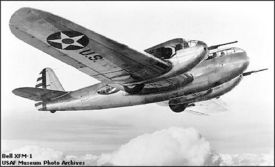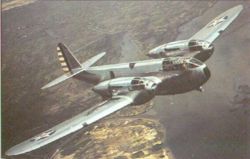PlaneSpottingWorld welcomes all new members! Please gives your ideas at the Terminal.
YFM Airacuda
| YFM Airacuda | |
|---|---|
| Type | Bomber destroyer |
| Manufacturer | Bell Aircraft |
| Designed by | Bob Woods |
| Maiden flight | 1 September 1937 |
| Retired | 1940 |
| Primary user | U.S. Army Air Corps |
| Number built | 13 |
The American Bell YFM-1 Airacuda was the first military aircraft produced by the Bell Aircraft Corporation. Originally designated the "Bell Model 1," the Airacuda first flew on 1 September 1937. The Airacuda was marked by bold design advances and considerable flaws that eventually grounded the plane.
The Airacuda was Bell Aircraft's answer for a "Bomber Destroyer" type aircraft. Although the aircraft did see limited production, and one fully operational squadron was eventually formed, only one prototype and thirteen production models were ultimately produced in three slightly different versions.
Contents
Design and development
In an effort to break into the airplane business, Bell Aircraft fashioned a unique fighter concept that was touted to be "a mobile anti-aircraft platform"[1] as well as a "convoy fighter."[2] Created to intercept enemy bombers at distances beyond the range of single-seat fighter interceptors, the YFM-1 (the designation was for (Y)a prototype (F) fighter (M) multiplace) was a unique design incorporating many features never before seen in a military aircraft, as well as several never seen again. Utilizing a streamlined, "futuristic" design, the Bell Airacuda appeared to be "unlike any other fighters up to that time."[3]
According to Major Alexander De Seversky's 1942 book, Victory Through Air Power, the Bell Airacuda "represents a great engineering achievement. But its designation as 'convoy fighter' is erroneous, since that requires different disposition of armament. With its maximum firepower directed forward, it really offers a preview of an effective long-range interceptor fighter."[4]
A single forward firing M4 37 mm cannon with an accompanying gunner was mounted in a forward compartment in each of the engine nacelles. Although capable of aiming the cannons, the gunner's primary purpose was simply to load them with the 110 rounds of ammunition stored in each nacelle.
The large crew of five included a fire-control officer in the nose who used a Sperry autopilot, a fire control system originally developed for anti-aircraft cannon, and an optical sight to aim the weapons. This crewmember could also use a periscope mounted below the nose to monitor the rear and, hopefully, spot enemy fighters coming up in the Airacuda's "blind spot."
Design flaws
The Airacuda was plagued with problems from the start. The lofty performance estimates were unobtainable as, despite the sleek look, the heavy Airacuda was dragged down (literally) and was slower than most bombers. In the event of interception by enemy fighters, the Airacuda was not maneuverable enough to dogfight, while the meager 600 lb (272 kg) bomb load was of little use in the intended fighter-bomber role. Even the centerpiece, main 37 mm cannon armament, were perilous to use. The cannons had a tendency to fill the gun nacelles with smoke whenever fired and, additionally, fears persisted as to how the gunners would escape in an emergency, with the propellers directly behind them. An emergency bailout would have required both propellers to be feathered.[5]
The Allison V-1710-13 engines, though relatively trouble free in other types, had no additional cooling systems. Like many pusher designs, they were prone to overheating. On the ground, the aircraft had to be towed to and from the runway and could only be started when the Airacuda was able to takeoff immediately. Even in the air it was not uncommon to experience overheating problems. Although designed for turbo-supercharging, the first flights were made with V-1710-9 carbureted engines that only delivered 1000 hp (76040 kg) each. Despite the long five ft shaft extensions, there were no problems with this feature. When the turbos were fitted to the later YFM-1, they were plagued by cranky turbo regulators that backfired continuously. An explosion during a September 1939 test flight made it apparent that the teething engine troubles would not be solved easily.[6]
Initial flight testing by Lt. Ben Kelsey proved the plane virtually impossible to control on a single engine, as the aircraft would go into an immediate spin. Pitch problems were also encountered, and had to be corrected by reducing power. Test pilot Erik Shilling described his experiences in a later book, Destiny: A Flying Tiger's Rendezvous With Fate as:
Flying the Bell Airacuda was a new experience for me, since it was the first pusher aircraft I'd ever flown. Its handling characteristics were foreign to anything I had ever had my hands on. Under power it was unstable in pitch, but stable with power off. While flying straight and level, if a correction in pitch was required, a forward push on the control resulted in the airplane wanting to pitch over even more. Pitch control became a matter of continually jockeying the controls, however slightly, even when the aircraft was in proper trim. The same applied if pulling back on the control. It would tend to continue pitching up, requiring an immediate corrective response. The same happened in a turn with power off, the Bell became stable in pitch. This was fortunate because during approach and landing, it was very stable, and a nice flying airplane."[7]
The Airacuda was also saddled by a complex and temperamental electrical system and was the only aircraft ever built to rely on an independent auxiliary power unit (APU) to power both engine fuel pumps, as well as all aircraft electrical systems.[8] Systems usually powered by an aircraft's engines were instead powered by the single generator. The generator, with its own supercharger, was located in the belly of the aircraft. In the event of a failure (and they occurred frequently), the crew was instructed to begin immediate emergency restart procedures as the aircraft basically shut down. When the APU failed, the pilot had "NO fuel pressure, NO vacuum, NO hydraulic pressure, NO gear, NO flaps and NO ENGINES.[9]"
Variants
The prototype, known as the XFM-1, incorporated a tail wheel, side "blister" ports, and a smooth, rounded canopy. This is the best known, and most produced version. An updated version called the YFM-1 eliminated the side blisters and added externally mounted radiators and turbo-superchargers. Produced in 1940, the final version designated YFM-1A, was slightly larger, had more powerful Allison engines and incorporated a tricycle landing gear. The canopy was redesigned, with a flat forward windshield. A rearward-facing belly gunner's position was also added. The resulting aircraft was roughly the size of a Douglas B-18 bomber. Three YFM-1As were produced in 1939.
Operational service
Despite these problems, one fully operational Airacuda squadron was eventually assembled, and operated from 1938 until 1940, although due to continuing problems, they were mainly "hangar queens."[10] Towards the end of the type's operational life, the aircraft were flown primarily for photo opportunities and always accompanied by a chase plane for safety. In late 1940, the aircraft were stricken from inventory. All 13 Airacudas were flown to a training facility located outside Chicago where they were used for ground crew instruction. Before the end of World War II, all Airacudas were ignominiously scrapped, ending a promising, if daunting technological venture.
Specifications (YFM-1A Airacuda)
General characteristics
- Crew: 5
- Length: 44 ft 10 in (13.67 m)
- Wingspan: 69 ft 10 in (21.29 m)
- Height: 13 ft 7 in (4.14 m)
- Wing area: 684 ft² (208.4832 m²)
- Empty weight: 13,376 lb (6,067 kg)
- Loaded weight: 17,333 lb (7,862 kg)
- Powerplant: 2× Allison V-1710 liquid-cooled supercharged V-12, 1,150 hp (48780 kg)1000 hp (76040 kg) each
Performance
- Maximum speed: 277 mph (446 km/h)
- Range: 2,600 miles (4,184 m)
- Service ceiling: 30,500 ft (9,300 m)
- Rate of climb: 24.6 ft/sec (7.5 m/sec)
Armament
- 2x 37 mm cannon
- 2x .50 machine guns
- 2x .30 machine guns
- 2x 300 lb (146kg) bombs
Avionics
References
- de Seversky Alexander P. Victory Through Air Power. New York: Simon and Schuster, 1942.
- Plummer, Pat. "The Victorious Vees." Wings Vol. 27, no. 4. August 1997.
- Winchester, Jim. The World's Worst Aircraft: From Pioneering Failures to Multimillion Dollar Disasters. London: Amber Books Ltd., 2005. ISBN 1-904687-34-2.
External links
Related content
Related development
Comparable aircraft
Related lists
See also
Fighter aircraft: YFM-1 · P-39 · P-59 · P-63 · XP-77 · XP-83
Commercial Helicopters: 47 · 204 · 205 · 206 · 210 · 212 · 214 · 222 · 230 · 407 · 412 · 417 · 427 · 429 · 430
Military Helicopters: H-13 · UH-1 · 207 · 209 · AH-1 · 309 · YAH-63 · OH-58 · ARH-70
Tiltrotors: V-22 · BA609 · TR918 · QTR
Experimental aircraft: X-1 · X-2 · X-5 · X-20 X-22 · XV-3 · XV-15 · 533 ·
Lists relating to aviation | |
|---|---|
| General | Timeline of aviation · Aircraft · Aircraft manufacturers · Aircraft engines · Aircraft engine manufacturers · Airports · Airlines |
| Military | Air forces · Aircraft weapons · Missiles · Unmanned aerial vehicles (UAVs) · Experimental aircraft |
| Notable incidents and accidents | Military aviation · Airliners · General aviation · Famous aviation-related deaths |
| Records | Flight airspeed record · Flight distance record · Flight altitude record · Flight endurance record · Most produced aircraft |


